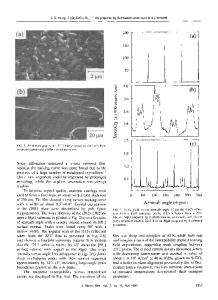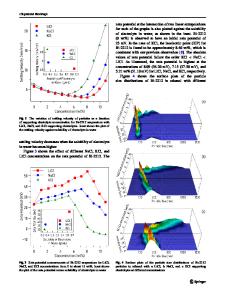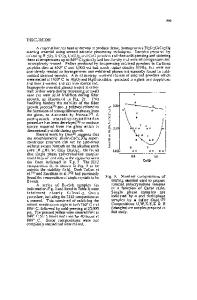Rapidly textured Bi 2 Sr 2 CaCu 2 O 8
- PDF / 1,960,667 Bytes
- 11 Pages / 576 x 792 pts Page_size
- 49 Downloads / 400 Views
T. G. Holesinger Argonne National Laboratory, Argonne, Illinois 60439
R.W. McCallum Ames Laboratory, Iowa State University, Ames, Iowa 50011 (Received 16 July 1992; accepted 2 February 1993)
Amorphous Bi 2 Sr 2 CaCu 2 0 8 (Bi-2212) was crystallized under uniaxial loads (up to 1500 N) at temperatures up to 890 °C to induce texture. Well-textured samples (19 mm in diameter and 0.15 mm thick) were obtained for samples heated to 890 °C and quenched. Heated (10 °C/min) and quenched samples at 550, 750, 850, and 870 °C demonstrate that the crystallization path is Bi 2 Sr 2 Cu0 6 (Bi-2201) (550 °C) to Bi-2212 (850 °C), with texturing occurring during grain growth ( r > 850 °C). Comparison of samples crystallized under load and no load demonstrates that the texturing is a result of the plane stress biasing the normal anisotropic grain growth normal to the applied stress direction.
I. INTRODUCTION Bulk applications of high-r c superconductors have been limited by the inability to fabricate them into long filaments or wires with critical currents of 10 5 -10 6 A/cm 2 in magnetic fields of several tesla at 77 K. Theoretical studies1 and experimental results with single crystals,2 epitaxial films,3 and melt-processed pellets4 assure us that it is possible to obtain high critical currents in cuprate superconductors. Critical currents in polycrystalline materials are limited by three factors: the weak-link nature of the grain boundaries,5'6 the anisotropy of the superconducting properties,7'8 and the large amount of flux creep.9'10 The limits due to the first two factors are decreased if highly textured polycrystalline material can be fabricated. Bismuthbased superconductors, Bi2Sr2CaCu2O8 (Bi-2212) and (Bi, Pb) 2 Sr 2 Ca 2 Cu 3 O 10 (Bi-2223), have been successfully textured by partial melt processing, mechanical deformation processing, or a combination of both.11"16 Melt processing has produced the best critical currents to date (105 A/cm 2 at 4.2 K in a magnetic field of 23 T). However, it is unlikely that it will be feasible to make long textured conductors with melt processing given the slow growth rates.4 Efforts must concentrate upon the development of textured polycrystalline cuprate superconductors via other processes. The purpose of this study has been to determine if a unique processing method can rapidly produce highly textured microstructures with improved properties. In this method, amorphous precursor material is crystallized at favorable reaction temperatures under uniaxial load. This technique can be classified as "glass-ceramic processing". The uniaxial stress field preferentially biases
the normally anisotropic grain growth to be normal to the applied load, resulting in a well-textured material. The applied load also contributes to increasing the density of the sample. This study has concentrated upon efforts to texture Bi-2212. This material was chosen because it can easily be made into a glass, has a high transition temperature (80-90 K), and is more stable than the Bi-2223 phase. II. EXPERIMENTAL PROCED
Data Loading...











